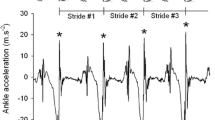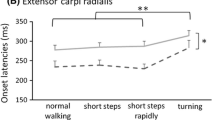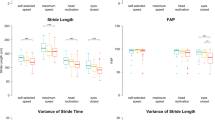Abstract
Patients with Parkinson's disease (PD) often experience freezing of gait, a debilitating phenomenon during which the subject suddenly becomes unable to start walking or to continue to move forward. Little is known about the gait of those subjects with PD who experience freezing of gait or the pathophysiology of freezing. One possibility is that freezing of gait is a truly paroxysmal phenomenon and that the usual walking pattern of subjects who experience freezing of gait is not different than that of other patients with PD who do not experience these transient episodes of freezing of gait. On the other hand, a recent study noted gait changes just prior to freezing and concluded that dyscontrol of the cadence of walking contributes to freezing. To address this question, we compared the gait of PD subjects with freezing of gait to PD subjects without freezing of gait. Given the potential importance of the dyscontrol of the cadence of walking in freezing, we focused on two aspects of gait dynamics: the average stride time (the inverse of cadence, a measure of the walking pace or rate) and the variability of the stride time (a measure of "dyscontrol," arrhythmicity and unsteadiness). We found that although the average stride time was similar in subjects with and without freezing, stride-to-stride variability was markedly increased among PD subjects with freezing of gait compared to those without freezing of gait, both while "on" (P<0.020) and "off" (P<0.002) anti-parkinsonian medications. Further, we found that increased gait variability was not related to other measures of motor control (while off medications) and levodopa apparently reduced gait variability, both in subjects with and without freezing. These results suggest that a paradigm shift should take place in our view of freezing of gait. PD subjects with freezing of gait have a continuous gait disturbance: the ability to regulate the stride-to-stride variations in gait timing and maintain a stable walking rhythm is markedly impaired in subjects with freezing of gait. In addition, these findings suggest that the inability to control cadence might play an important role in this debilitating phenomenon and highlight the key role of dopamine-mediated pathways in the stride-to-stride regulation of walking.
Similar content being viewed by others
References
Achiron A, Ziv I, Goren M, Goldberg H, Zoldan Y, Sroka H, Melamed E (1993) Primary progressive freezing gait. Mov Disord 8:293–297
Aita JF (1982) Why patients with Parkinson's disease fall. JAMA 247:515–516
Ambani LM, Van Woert MH (1973) Start hesitation—a side effect of long-term levodopa therapy. N Engl J Med 288:1113–1115
Andrews CJ (1973) Influence of dystonia on the response to long-term l-dopa therapy in Parkinson's disease. J Neurol Neurosurg Psychiatry 36:630–636
Biglan K, Holloway RG (2001) Initial treatment of early Parkinson's disease: a review of recent, randomized controlled trials. Curr Neurol Neurosci Rep 1:329–336
Blin O, Ferrandez AM, Pailhous J, Serratrice G (1991) Dopa-sensitive and dopa-resistant gait parameters in Parkinson's disease. J Neurol Sci 103:51–54
Fabre N, Brefel C, Sabatini U, Celsis P, Montastruc JL, Chollet F, Rascol O (1998) Normal frontal perfusion in patients with frozen gait. Mov Disord 13:677–683
Fahn S (1995) The freezing phenomenon in parkinsonism. Adv Neurol 67:53–63
Fahn S, Elton R, members of the UPDRS Developmental Committee (1987) Unified Parkinson's disease rating scale. In: Fahn S, Marsden CD, Calne DB, Goldstein M (eds) Recent developments in Parkinson's disease. Florham Park, NJ, pp 153–163
Folstein MF, Folstein SE, McHugh PR (1975) "Mini-mental state". A practical method for grading the cognitive state of patients for the clinician. J Psychiatr Res 12:189–198
Gelb DJ, Oliver E, Gilman S (1999) Diagnostic criteria for Parkinson disease. Arch Neurol 56:33–39
Giladi N (2001) Freezing of gait. Clinical overview. Adv Neurol 87:191–197
Giladi N, McMahon D, Przedborski S, Flaster E, Guillory S, Kostic V, Fahn S (1992) Motor blocks in Parkinson's disease. Neurology 42:333–339
Giladi N, Kao R, Fahn S (1997) Freezing phenomenon in patients with parkinsonian syndromes. Mov Disord 12:302–305
Giladi N, Shabtai H, Simon ES, Biran S, Tal J, Korczyn AD (2000) Construction of freezing of gait questionnaire for patients with Parkinsonism. 6:165–170
Giladi N, Gurevich T, Shabtai H, Paleacu D, Simon ES (2001a) The effect of botulinum toxin injections to the calf muscles on freezing of gait in parkinsonism: a pilot study. J Neurol 248:572–576
Giladi N, McDermott MP, Fahn S, Przedborski S, Jankovic J, Stern M, Tanner C (2001b) Freezing of gait in PD: prospective assessment in the DATATOP cohort. Neurology 56:1712–1721
Giladi N, Bartlels A, Balash Y, Schaafsma J, Gurevitch T, Comanester D, Hausdorff JM (2002) How is freezing of gait in patients with PD related to akinesia/bradykinesia? Neurology 58 (Suppl 3):P04.060
Gray P, Hildebrand K (2000) Fall risk factors in Parkinson's disease. J Neurosci Nurs 32:222–228
Halliday SE, Winter DA, Frank JS, Patla AE, Prince F (1998) The initiation of gait in young, elderly, and Parkinson's disease subjects. Gait Posture 8:8–14
Hausdorff JM, Ladin Z, Wei JY (1995) Footswitch system for measurement of the temporal parameters of gait. J Biomech 28:347–351
Hausdorff JM, Cudkowicz ME, Firtion R, Wei JY, Goldberger AL (1998) Gait variability and basal ganglia disorders: stride-to-stride variations of gait cycle timing in Parkinson's disease and Huntington's disease. Mov Disord 13:428–437
Hausdorff JM, Lertratanakul A, Cudkowicz ME, Peterson AL, Kaliton D, Goldberger AL (2000) Dynamic markers of altered gait rhythm in amyotrophic lateral sclerosis. J Appl Physiol 88:2045–2053
Hausdorff JM, Rios DA, Edelberg HK (2001) Gait variability and fall risk in community-living older adults: a 1-year prospective study. Arch Phys Med Rehabil 82:1050–1056
Hely MA, Morris JG, Traficante R, Reid WG, O'Sullivan DJ, Williamson PM (1999) The Sydney multicentre study of Parkinson's disease: progression and mortality at 10 years. J Neurol Neurosurg Psychiatry 67:300–307
Hoehn MM, Yahr MD (1967) Parkinsonism: onset, progression and mortality. Neurology 17:427–442
Imai H, Nakamura T, Kondo T, Narabayashi H (1993) Dopa-unresponsive pure akinesia or freezing. A condition within a wide spectrum of PSP? Adv Neurol 60:622–625
Lamberti P, Armenise S, Castaldo V, de Mari M, Iliceto G, Tronci P, Serlenga L (1997) Freezing gait in Parkinson's disease. Eur Neurol 38:297–301
Leenders KL, Oertel WH (2001) Parkinson's disease: clinical signs and symptoms, neural mechanisms, positron emission tomography, and therapeutic interventions. Neural Plast 8:99–110
Maki BE (1997) Gait changes in older adults: predictors of falls or indicators of fear. J Am Geriatr Soc 45:313–320
Morris ME, Iansek R, Matyas TA, Summers JJ (1994) The pathogenesis of gait hypokinesia in Parkinson's disease. Brain 117:1169–1181
Morris ME, Iansek R, Matyas TA, Summers JJ (1996) Stride length regulation in Parkinson's disease. Normalization strategies and underlying mechanisms. Brain 119:551–568
Morris M, Iansek R, Matyas T, Summers J (1998) Abnormalities in the stride length-cadence relation in parkinsonian gait. Mov Disord 13:61–69
Nakamura T, Meguro K, Sasaki H (1996) Relationship between falls and stride length variability in senile dementia of the Alzheimer type. Gerontology 42:108–113
Nieuwboer A, Dom R, De Weerdt W, Desloovere K, Fieuws S, Broens-Kaucsik E (2001) Abnormalities of the spatiotemporal characteristics of gait at the onset of freezing in Parkinson's disease. Mov Disord 16:1066–1075
Ouchi Y, Kanno T, Okada H, Yoshikawa E, Futatsubashi M, Nobezawa S, Torizuka T, Tanaka K (2001) Changes in dopamine availability in the nigrostriatal and mesocortical dopaminergic systems by gait in Parkinson's disease. Brain 124:784–792
Sheridan MR, Flowers KA, Hurrell J (1987) Programming and execution of movement in Parkinson's disease. Brain 110:1247–1271
Yanagisawa N, Hayashi R, Mitoma H (2001) Pathophysiology of frozen gait in Parkinsonism. Adv Neurol 87:199–207
Acknowledgements
This work was supported in part by NIH grants AG-14100, RR-13622, HD-39838 and AG-08812. We thank E. Shabtai and D. Comanshter for assistance with statistical analysis and the subjects for their time and effort.
Author information
Authors and Affiliations
Corresponding author
Rights and permissions
About this article
Cite this article
Hausdorff, J.M., Schaafsma, J.D., Balash, Y. et al. Impaired regulation of stride variability in Parkinson's disease subjects with freezing of gait. Exp Brain Res 149, 187–194 (2003). https://doi.org/10.1007/s00221-002-1354-8
Received:
Accepted:
Published:
Issue Date:
DOI: https://doi.org/10.1007/s00221-002-1354-8




